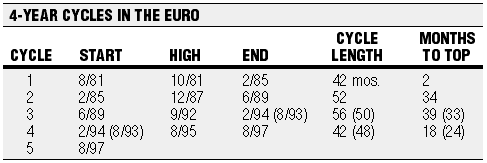MARKET TIMING
The Euro's Weekly Cycles
by Walter Bressert and Doug Schaff
As a followup to last month's introduction to the newborn European currency, here's what may happen to the Euro.
On January 4, 1999, the 40-odd years of planning and 10 years of political and economic work paid off as the Euro began trading in a calm, orderly manner. But what's the bottom line? How will improved efficiencies from a single currency affect Europe's competitiveness? When will the Euro's status as a reserve currency begin to shift demand away from US dollars?

FIGURE 1: EURO CYCLES. Our article last month discovered a four-year cycle in the Euro similar to ones in the ECU and dollar-mark. Since 1981, there have been five such four-year cycles in the Euro.The brand-new European Central Bank (ECB) is determined to establish its credibility. Europeans, on the other hand, having accepted large doses of fiscal and monetary tightening to establish the Euro, are now ready for payback in the form of economic growth.
*This alternate bottom for Euro cycle 3 corresponds to the low date of the ECU's cycle 3. Information in parentheses is based on that.
In the midst of this uncertainty, it's not so surprising that the Euro initially put in a weak price performance. Starting off at 1.1630, it quickly put in its high just above 1.1900 and by mid-February had traded down to 1.1200. The fundamentals will probably sort themselves out by summer. By then, the economic slowdown in Europe will most likely be over.
In the meantime, cycle analysis offers guidelines regarding time and price levels at which the Euro should bottom. Let us apply additional technical tools, oscillators, and trend indicators to develop a trading methodology for the Euro using weekly cycles.
OVERVIEW
As explained in our previous article, the Euro has a dominant four-year cycle that bottomed in August 1997. The market is currently coming into 20- and 40-week cycle lows that could begin a significant upmove. As of March 31, we expect this low to occur no later than the end of April and to mark the start of a sustained move higher. We look initially for the Euro to reach 1.1150 by mid-June and 1.1550 by mid-July. A Friday close above 1.1550 could be followed by a test of the 1.18 to 1.19 level in the September-October time frame. This price level should contain the upmove, even if Europe's economic growth picks up relative to the US as expected, and if US financial markets take a pause or correct downward.
The cycles and price levels are based on synthetic Euro prices from Bridge Channel's EuroCalc, calculated using historical foreign exchange prices for each of the participating countries. (EuroCalc is an online Web-based service that allows user-defined inputs to generate a synthetic foreign exchange Euro history by treating the Euro as a basket of currencies like the ECU.) The synthetic Euro prices fit seamlessly into actual interbank prices as the Euro began trading on January 4. We have confidence in this price data and therefore believe the analysis gives important guidelines as to where the Euro is likely to bottom and the extent of the coming move.
LONG-TERM CYCLES
Our article last month discovered a four-year cycle in the Euro similar to ones in the ECU and dollar-mark. Since 1981, there have been five such four-year cycles in the Euro.